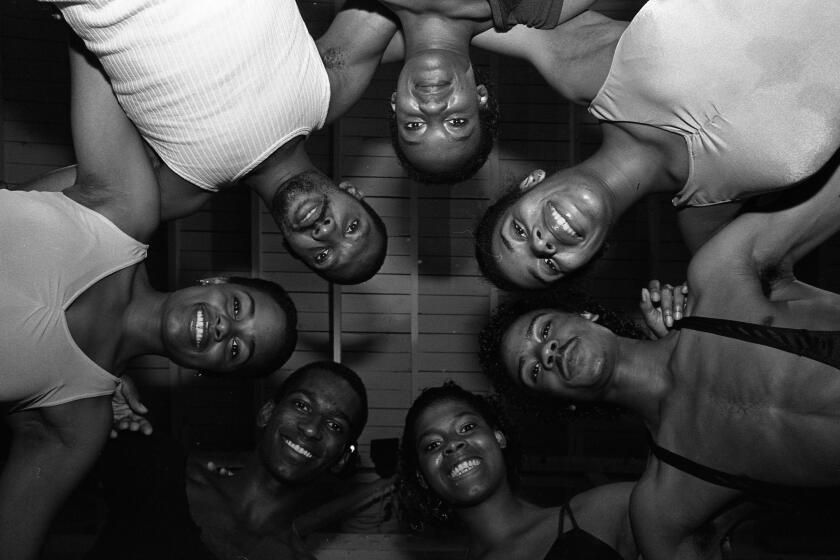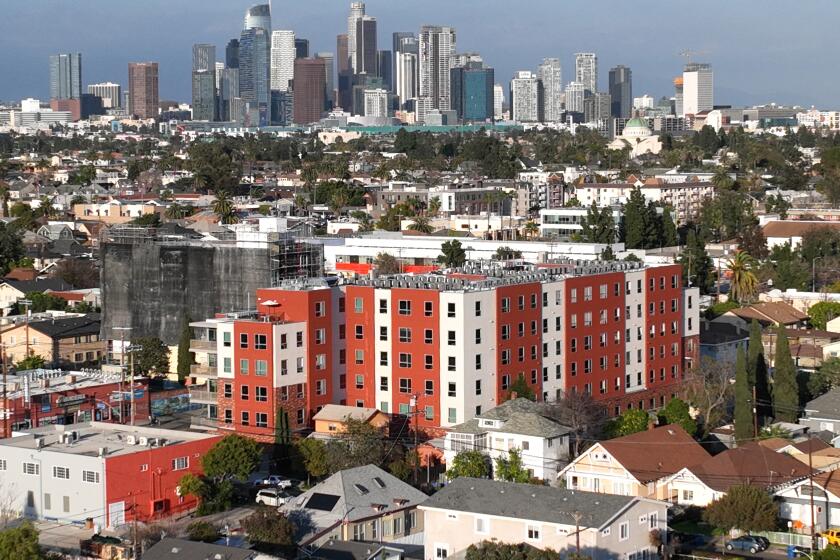Black reporter finds doors hard to open
- Share via
This story originally ran in 1982 as part of the “Black L.A.: Looking at Diversity” series. We have preserved the original text in order to provide an accurate account of the work in print.
The door slammed with a thud, followed quickly by the click of the lock.
For a moment, Art Nauman, my new boss, along with my wife and me, just stood there staring almost foolishly at the door. Nauman, managing editor of the Pulitzer Prize-winning Riverside Press Enterprise, had put together a list of supposedly “safe” apartments he thought would rent to blacks.
But when the managers at Riverside’s Emerald Gardens saw us coming up the walkway that summer of 1968, they beat a hasty retreat inside and pretended not to be at home.
Nauman’s face slowly turned red as he knocked politely on the door. No answer. Struggling to remain calm, he double-checked the address against his list. Suddenly he erupted.
“I know you’re in there,” he shouted, pounding on the door with his fists. “Open up.”
Still no answer.
Whites Admitted
My wife squeezed my hand reassuringly, and we headed back to the car. As we were leaving, a group of white prospective tenants made their way past us up the walk to the door where they were quickly swept inside. Now I was angry; Nauman was incensed.
He scrambled back to the apartment and caught the manager before he could close the door.
Why hadn’t they opened the door? Nauman demanded.
The manager said they hadn’t heard a knock. Moreover, there were no vacancies.
Nauman glanced at the vacancy sign still in the window and glared at the man. The man’s wife came to the door and mumbled something I couldn’t make out. The conversation ended, and the door shut once again.
Nauman’s premise had been that his presence would eliminate such scenes, that he would be my human passport to a decent apartment. It was not working. We spent the entire day being turned down.
In the summer of 1982, The Times published a series on Southern California’s Black community called “Black L.A.: Looking at Diversity.”
Decaying Apartments
During our search, we saw the decaying, overcrowded apartments on Riverside’s east side where most blacks lived. We also noted the well-kept houses sprinkled through the area. We could not afford a house on my new $125 weekly salary and didn’t want to live in the decrepit apartments—and no one would admit us to the more desirable all-white units.
I had just graduated from California State University, Los Angeles, and my wife, Lois, and I had driven rather cheerfully from Los Angeles out to Riverside to find a place to live near my new job.
“This reminds me of a sleepy Southern town,” I remarked to Lois.
Growing up in Texas, I had spent most of my youth in such towns—Huntsville, Clay, Earth, Mule Shoe, Somersville—as my stepfather, a Methodist minister, moved from one pastorate to another. Bathrooms and drinking fountains were always labeled “White” and “Colored.” Blacks used the back door to get service at restaurants, and every black child learned early on that white men were always addressed, “Yes, Sir” and “No, Sir.”
I had left Texas more than 20 years ago, never to return.
Fruitless Hunting
After our fruitless day of apartment hunting with Nauman, I had said to hell with the job and headed back to Los Angeles. How are you going to work in a place where you can’t live?
But 10 miles outside of Riverside, we spotted Country Club Village, a largely empty 115-acre apartment complex just off California 60 in Mira Loma. The owners desperately needed tenants, and rent was cheap—$120 for two bedrooms, air conditioning, stove and refrigerator.
We moved in.
I worked in Riverside for two years, although Lois and I never lived in the city of Riverside. Still it was home, the urban hub for sparsely populated outlying areas, including Mira Loma.
In many ways my job was great. There were some older staff members who were cordial to fellow coworkers but who never spoke to me. But for the most part, the reporters were young, ambitious and friendly. We fretted over stories, cursed editors under our breath, struggled through deadlines together. At day’s end we often lifted a beer together, especially at Friday night house parties.
Frustrating Moments
On the other hand, the job had its frustrating moments. Other reporters, coats flying and notepads clutched tightly in hand, rushed off to the important stories while I was assigned to some boring meeting or a burglary arrest worth three paragraphs.
After nearly two years of such assignments, I developed a constant headache. Then came the doubts and questions. Was I getting a steady stream of minor stories because I was black? Or was it because I was inexperienced?
Convinced that I was on the verge of a heart attack, I saw a local black doctor who told me I was suffering from nervous tension. Shortly afterward, I took a new reporting job in San Bernardino. The pay and the assignments were better. The tension left and the headaches disappeared.
That was almost 12 years, 20 pounds, a new house, and more than a few gray hairs ago.
Driving out to Riverside recently, I reminisced about Paul Scott, my old journalism professor, as I passed my alma mater.
“Get your teaching certificate,” he warned me one afternoon in his cramped office. “Play it safe. It’s tough placing Negro students at papers.”
Eventually Scott and a classmate helped me land a job in Whittier, where my classmate’s father was managing editor of the paper. From there I went to the Press Enterprise.
Continuing down the freeway, I passed Country Club Village, our first home in the area—a place to have a son and entertain friends. A few more minutes of driving, and I was in Riverside.
Computer terminals had replaced most of the old typewriters at the Press Enterprise, but the well-worn battleship gray desks remained. Although Nauman had departed for the Sacramento Bee, some familiar faces remained. Those who did not speak then did not greet me this time.
There was only one black face on the reporting staff—even fewer than in my day.
I went in to see “His Honor,” Associate Editor Norman Cherniss, the man who had hired me in 1968. Cherniss, short and balding, told me that the difficulty in hiring black reporters was and is finding “qualified people.”
“I suspect that the larger papers hire the better kids,” he said, lighting his pipe. “Probably most of them don’t want to leave the big cities for a little newspaper. Or maybe there just aren’t as many minority students interested in careers in journalism.”
Riverside, with 12,000 blacks in its population of 170,000, is now integrated, some blacks say. “Blacks can live anywhere they have money to buy,” George Williams, former president of the local NAACP, told me.
Only Seven Officers
A black sits on the school board, but the police force has only seven black officers on a force of 250.
On the east side, black men, mostly in their 20s, stood idly outside the decaying storefronts.
“The solution, the same as it was in the 1970s, is jobs,” Williams said.
I decided to try to find the apartment building where my wife and I were humiliated nearly 12 years ago. I couldn’t remember the address and the telephone operator could find no listing for an Emerald Gardens apartment complex. Maybe a cabbie could help.
I flagged down a cab driven by Kelsey Jones, a 26-year-old black man who said he has a degree in hospital administration but drives a cab because he has not been able to find work in his field.
After riding for about an hour, we could not find the complex. I related to Jones the comments I had heard about Riverside’s racial progress.
He cautioned me not to be fooled by appearances. He said that a landlord recently told him over the phone that an apartment was vacant, only to tell him after he arrived that the place had been rented.
“I went to a phone and called again,” Jones said. “The same damned guy said the apartment was still vacant.”
I was home.
More to Read
Sign up for Essential California
The most important California stories and recommendations in your inbox every morning.
You may occasionally receive promotional content from the Los Angeles Times.







